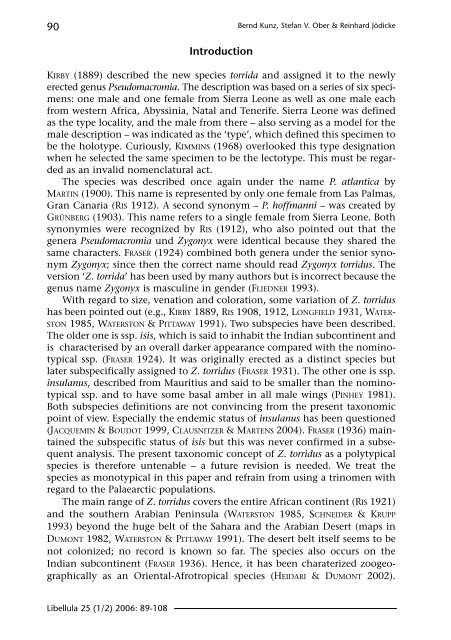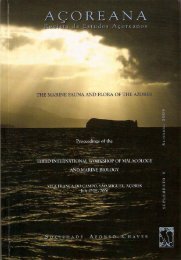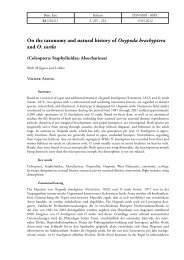The distribution of Zygonyx torridus in the Palaearctic (Odonata ...
The distribution of Zygonyx torridus in the Palaearctic (Odonata ...
The distribution of Zygonyx torridus in the Palaearctic (Odonata ...
You also want an ePaper? Increase the reach of your titles
YUMPU automatically turns print PDFs into web optimized ePapers that Google loves.
90<br />
Libellula 25 (1/2) 2006: 89-108<br />
Introduction<br />
Bernd Kunz, Stefan V. Ober & Re<strong>in</strong>hard Jödicke<br />
KIRBY (1889) described <strong>the</strong> new species torrida and assigned it to <strong>the</strong> newly<br />
erected genus Pseudomacromia. <strong>The</strong> description was based on a series <strong>of</strong> six specimens:<br />
one male and one female from Sierra Leone as well as one male each<br />
from western Africa, Abyss<strong>in</strong>ia, Natal and Tenerife. Sierra Leone was def<strong>in</strong>ed<br />
as <strong>the</strong> type locality, and <strong>the</strong> male from <strong>the</strong>re – also serv<strong>in</strong>g as a model for <strong>the</strong><br />
male description – was <strong>in</strong>dicated as <strong>the</strong> ‘type’, which def<strong>in</strong>ed this specimen to<br />
be <strong>the</strong> holotype. Curiously, KIMMINS (1968) overlooked this type designation<br />
when he selected <strong>the</strong> same specimen to be <strong>the</strong> lectotype. This must be regarded<br />
as an <strong>in</strong>valid nomenclatural act.<br />
<strong>The</strong> species was described once aga<strong>in</strong> under <strong>the</strong> name P. atlantica by<br />
MARTIN (1900). This name is represented by only one female from Las Palmas,<br />
Gran Canaria (RIS 1912). A second synonym – P. h<strong>of</strong>fmanni – was created by<br />
GRÜNBERG (1903). This name refers to a s<strong>in</strong>gle female from Sierra Leone. Both<br />
synonymies were recognized by RIS (1912), who also po<strong>in</strong>ted out that <strong>the</strong><br />
genera Pseudomacromia und <strong>Zygonyx</strong> were identical because <strong>the</strong>y shared <strong>the</strong><br />
same characters. FRASER (1924) comb<strong>in</strong>ed both genera under <strong>the</strong> senior synonym<br />
<strong>Zygonyx</strong>; s<strong>in</strong>ce <strong>the</strong>n <strong>the</strong> correct name should read <strong>Zygonyx</strong> <strong>torridus</strong>. <strong>The</strong><br />
version ‘Z. torrida’ has been used by many authors but is <strong>in</strong>correct because <strong>the</strong><br />
genus name <strong>Zygonyx</strong> is mascul<strong>in</strong>e <strong>in</strong> gender (FLIEDNER 1993).<br />
With regard to size, venation and coloration, some variation <strong>of</strong> Z. <strong>torridus</strong><br />
has been po<strong>in</strong>ted out (e.g., KIRBY 1889, RIS 1908, 1912, LONGFIELD 1931, WATER-<br />
STON 1985, WATERSTON & PITTAWAY 1991). Two subspecies have been described.<br />
<strong>The</strong> older one is ssp. isis, which is said to <strong>in</strong>habit <strong>the</strong> Indian subcont<strong>in</strong>ent and<br />
is characterised by an overall darker appearance compared with <strong>the</strong> nom<strong>in</strong>otypical<br />
ssp. (FRASER 1924). It was orig<strong>in</strong>ally erected as a dist<strong>in</strong>ct species but<br />
later subspecifically assigned to Z. <strong>torridus</strong> (FRASER 1931). <strong>The</strong> o<strong>the</strong>r one is ssp.<br />
<strong>in</strong>sulanus, described from Mauritius and said to be smaller than <strong>the</strong> nom<strong>in</strong>otypical<br />
ssp. and to have some basal amber <strong>in</strong> all male w<strong>in</strong>gs (PINHEY 1981).<br />
Both subspecies def<strong>in</strong>itions are not conv<strong>in</strong>c<strong>in</strong>g from <strong>the</strong> present taxonomic<br />
po<strong>in</strong>t <strong>of</strong> view. Especially <strong>the</strong> endemic status <strong>of</strong> <strong>in</strong>sulanus has been questioned<br />
(JACQUEMIN & BOUDOT 1999, CLAUSNITZER & MARTENS 2004). FRASER (1936) ma<strong>in</strong>ta<strong>in</strong>ed<br />
<strong>the</strong> subspecific status <strong>of</strong> isis but this was never confirmed <strong>in</strong> a subsequent<br />
analysis. <strong>The</strong> present taxonomic concept <strong>of</strong> Z. <strong>torridus</strong> as a polytypical<br />
species is <strong>the</strong>refore untenable – a future revision is needed. We treat <strong>the</strong><br />
species as monotypical <strong>in</strong> this paper and refra<strong>in</strong> from us<strong>in</strong>g a tr<strong>in</strong>omen with<br />
regard to <strong>the</strong> <strong>Palaearctic</strong> populations.<br />
<strong>The</strong> ma<strong>in</strong> range <strong>of</strong> Z. <strong>torridus</strong> covers <strong>the</strong> entire African cont<strong>in</strong>ent (RIS 1921)<br />
and <strong>the</strong> sou<strong>the</strong>rn Arabian Pen<strong>in</strong>sula (WATERSTON 1985, SCHNEIDER & KRUPP<br />
1993) beyond <strong>the</strong> huge belt <strong>of</strong> <strong>the</strong> Sahara and <strong>the</strong> Arabian Desert (maps <strong>in</strong><br />
DUMONT 1982, WATERSTON & PITTAWAY 1991). <strong>The</strong> desert belt itself seems to be<br />
not colonized; no record is known so far. <strong>The</strong> species also occurs on <strong>the</strong><br />
Indian subcont<strong>in</strong>ent (FRASER 1936). Hence, it has been charaterized zoogeographically<br />
as an Oriental-Afrotropical species (HEIDARI & DUMONT 2002).
















